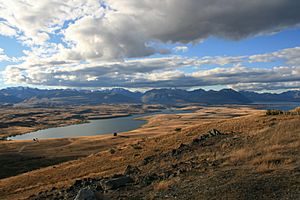High country (New Zealand) facts for kids
The High country is a special name in New Zealand for the elevated land used for farming, mostly in the South Island. You can think of it as New Zealand's version of the "outback" in Australia or the "veld" in South Africa. This land is usually found in the rain shadow of New Zealand's big mountain ranges, meaning it doesn't get much rain. It has a continental climate, which means hot summers and cold winters. Farmers here raise animals like sheep, deer, and alpaca. A common plant covering the ground is tussock grass.
Contents
What is New Zealand's High Country?
The High country refers to large areas of land in New Zealand that are high up, often more than 600 metres (about 2,000 feet) above sea level. This land is mainly used for a type of farming called extensive farming. This means farmers use very large areas of land to raise their animals, rather than having many animals on a small piece of land.
Where is the High Country?
Most of New Zealand's High country is found in the South Island. Key areas include Central Otago and the Mackenzie Basin. There are also some parts of the North Island Volcanic Plateau that are considered High country. These regions are known for their wide-open spaces and stunning natural beauty.
Life in the High Country: Climate and Farming
The climate in the High country is quite unique for New Zealand. Because it's in the rain shadow of the mountains, it doesn't get a lot of rainfall. It experiences a continental climate, which means the summers can be very hot, and the winters are often very cold with snow.
Farmers in the High country traditionally raised sheep, especially for their wool. However, in recent years, many farmers have also started raising deer and alpacas. These animals are well-suited to the tough conditions and can graze on the tussock grass that grows widely across the land.
Amazing Landscapes: Lakes and Glaciers
The landscapes of the High country are truly amazing and have been shaped over thousands of years. Many of the features you see today were created by glaciation during the last ice age. Huge glaciers carved out deep valleys, which later filled with water to form long, finger-shaped lakes. Famous examples include Lake Wanaka and Lake Tekapo. These lakes are known for their clear, often turquoise, waters.
Protecting the High Country: Conservation Challenges
The High country is a very important natural area, and there are several challenges to keep it healthy and protected. Some of the land is leased from the government by farmers. A process called "tenure review" helps decide if this land should become privately owned by farmers or if it should be protected for conservation.
What are Wilding Conifers?
One big problem in the High country is "wilding conifers." These are conifer trees (like pine trees) that have spread from planted forests and are now growing wild in areas where they don't belong. They can take over the native tussock grasslands and change the natural landscape. This can also affect native plants and animals that rely on the open tussock environment.
Dealing with Pests and Erosion
Other conservation issues include invasive plants like hieracium, which is a type of weed that can spread quickly and outcompete native plants. Soil erosion is also a concern, especially in areas where the land has been disturbed or overgrazed. This is when the soil washes away, often during heavy rain or wind. Finally, rabbit plagues can be a major problem. Too many rabbits eat vast amounts of vegetation, which damages the land and can lead to more erosion. Efforts are constantly being made to manage these issues and protect the unique environment of the High country.


